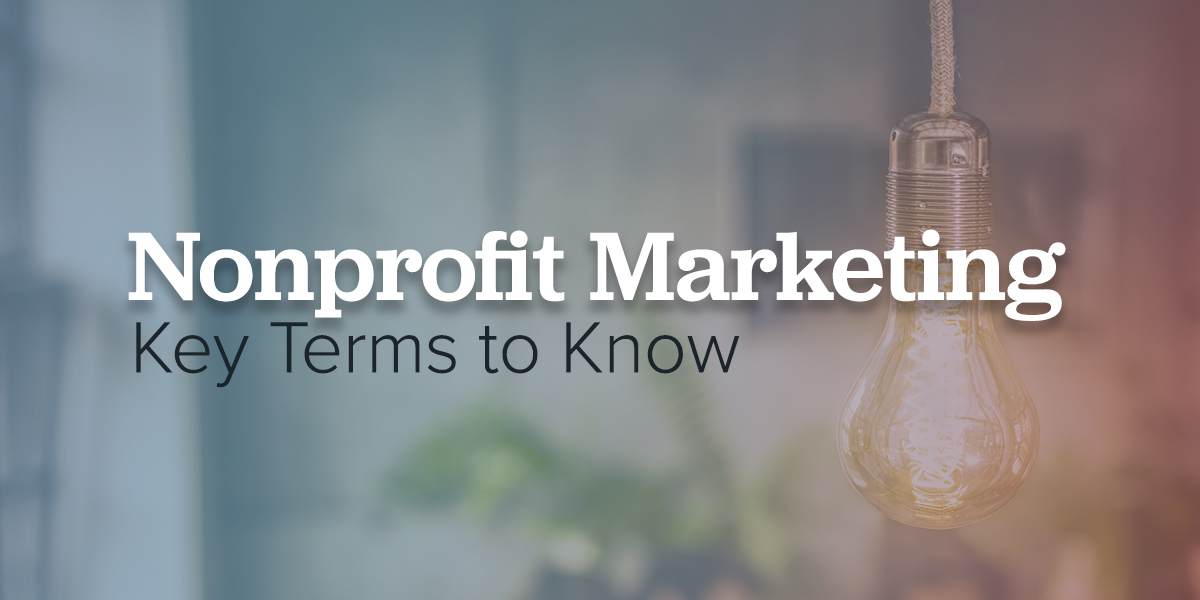Nonprofit Digital Marketing Terms To Know
Ilia Jones | November 2021

Whether you’re new to marketing or are an experienced marketer dipping your toes into digital marketing, it may seem like you need to learn a whole new language to understand what’s happening. There are many terms that are unique to digital marketing that can be helpful to understand.
We’ve put together this guide of commonly used digital marketing terms to help you learn the language of digital marketing.
Digital Marketing Terms Nonprofits Should Know
To help you understand and contextualize how all of these terms and concepts fit together, we’ve organized them into categories.
- Digital Marketing
- Content Marketing
- Email Marketing
- Social Media Marketing
Are you ready for your language lesson? Let’s go!
Digital Marketing
Digital marketing can be a kind of catch-all term for any marketing done online. And it often is used as an overarching term that includes email marketing, social media marketing, and other content marketing. But there are some specific tasks and tactics that fall under digital marketing, such as search engine optimization, analytics, tags, and other duties specific to running a website.
Landing Page
A landing page is a unique web page created as a destination for a specific call to action or link. An effective landing page should have a title that matches the information in the ad, CTA or other content that directed a visitor to that page. It should also have a clear purpose, such as encouraging donations or selling tickets to a fundraising event.
Search Engine Optimization. or SEO
SEO is the tactic used, usually in the form of keywords, to boost a website to the top of a search results page. A strong SEO strategy is essential to making sure your website is easily found online. Other important aspects of SEO include quality content, page length, user experience, and page load times.
META TAGS
Meta tags are used on web pages to indicate what the page is about. Tags include a Meta Title and Meta Description. It’s essential that the meta tags accurately describe the page’s content and should be considered in your SEO strategy as well. Search engine crawlers use tags to index the pages of your website.
Content Marketing
Content marketing is a category within digital marketing that focuses on content creation, sharing, and thought leadership. Content marketing is used strategically to create content, such as a blog, infographic, or video. These feed social media posts and showcase the thought leadership in your nonprofit organization.
The strategy around content marketing is to create valuable and engaging content. Then to share it on social media and use that promotion to drive traffic back to your website to, hopefully, convert visitors into members of your donor community.
Blog
While blogs may have gotten their start as online diaries, they are now used by businesses, nonprofits, and individuals to help share knowledge and information, tell inspiring stories or illustrate thought leadership. These blogs are used as marketing tools that offer new content on a regular basis, often weekly or bi-weekly. This fresh content keeps website visitors coming back. And over time builds into a veritable knowledge warehouse that users can find through search engines or a search function built into your website.
Ebook
Ebooks, or electronic books, are long-form content that can be read on computers or mobile devices. They are frequently shared as PDFs or are available on platforms like Kindle. While they are generally longer than a blog post, they can be shorter than traditional paperback books. The purpose of an ebook is to share content that explains a specific topic in more depth than may be possible in other marketing materials.
Ebooks are considered premium content, which means that they may require a nominal fee or the submission of the purchaser’s contact information for marketing purposes. This makes ebooks a great way to grow your mailing list or earn the trust of your audience by sharing your in-depth knowledge.
Thought Leadership
Thought leadership is the well-informed and experienced knowledge typically held by leaders in an organization or industry. This knowledge can be shared in content marketing, whitepapers, blog posts, and other formats to showcase your organization as forward-thinking and innovative.
Thought leaders may also be influencers or may have extended reach and large followings on social media due to their experience in the field or reputation.
Editorial Calendar
In order to keep track of the content created and published on all channels, digital marketing teams use an editorial calendar. It’s helpful to have an editorial calendar to plan and track blog posts, social media promotions, email newsletters, and other ways you share your content.
In addition to helping to keep track, an editorial calendar is also a helpful tool for maintaining consistency in your digital marketing. Some social media publishing tools have editorial calendars built-in, or you can create a simple spreadsheet.
Email Marketing
Email marketing has been around for a long time. However, it is still one of the most effective digital marketing strategies for nonprofits and other organizations. Email marketing uses email to communicate news, celebrate successes, announce upcoming events and promote fundraising efforts.
For email marketing to work, it’s essential that you start to gather email addresses from your website visitors, existing donors, and volunteers. You can also use premium content to grow your email list by requiring those interested to enter their contact information to access it. This is known as gated content.
Your email campaigns aren’t likely to be effective without this contact information for an already warm audience.
Email Campaign
Speaking of email campaigns, what are they? Rather than sending out random emails to your contact list, an email campaign is an organized series of email communications deployed over a specific amount of time with a goal in mind.
For example, you may set up an email campaign to get people pumped up about Giving Tuesday. The first email may simply let people know that it’s coming up and remind them why it exists. The next email could include your nonprofit’s specific goals for Giving Tuesday and what you plan to do with the donations. Subsequent emails may be sent the week before Giving Tuesday, the week of, and then the day of. Then, followed by a thank you email afterward, showing your appreciation for your donors’ generosity.
Email campaigns work to raise awareness, inspire action and show gratitude to nurture your audience for future marketing efforts.
Call to Action
A call to action is a trigger for your audience to do a specific action. The action may be donating, volunteering, purchasing something, or registering for a fundraising event. While a call to action, or CTA, is not exclusive to email marketing, it is essential for any good marketing email.
A good CTA should be visible, eye-catching, legible, and use brief, impactful text that clearly states the desired action. It may be a button in a contrasting color, a bold-faced block of text, or some other format that makes it stand out from the surrounding text.
For an extra competitive edge, a CTA may have its own landing page. This helps avoid confusion about where website visitors find themselves. And so they can accomplish the desired action quickly and easily.
Opt-Out
The option to opt out of receiving emails from an organization is a critical part of any email sent by your organization. It can be useful if people feel as though they are being spammed by too many emails. They have a legal right to unsubscribe from specific types of emails or to remove themselves from your email list entirely.
Social Media Marketing
Social media marketing includes any presence or promotion your organization does on social media platforms like Facebook, Instagram, Pinterest, TikTok, or LinkedIn. There are many social media platforms to choose from and they all work a little bit differently and have different trends. However, any social media presence will help your organization gain visibility and credibility.
Followers
Followers on social media are the people that track and interact with your brand on that platform. Typically, gaining new followers and engaging the followers you already have are the primary goals of any social media marketing campaign.
Engagement
On social media, any interaction you have with your followers is called engagement. It can be as simple as them liking a post of yours, sharing it with their friends and followers, or conversations and comments around social media posts.
Hashtags
Hashtags or “#” are used on social media to highlight specific topics. Twitter was the first social media platform to use hashtags to track trending conversations or events. Hashtags are now used on Instagram (as well as Facebook and LinkedIn to an extent) to organize content and make it easier for the right content to be seen by the right people. You can create a hashtag for your organization, use hashtags that describe your cause, or highlight volunteer opportunities.
Learning the Language of Digital Marketing
Diving into digital marketing can seem like learning a new language. And it is! But, once you understand these terms, you can keep up with the rest of the team and with the ever-changing trends in the digital marketing space.
